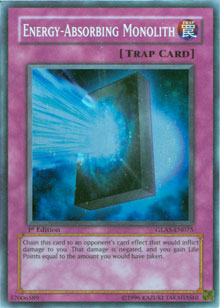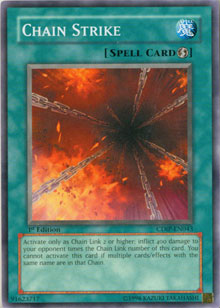 Energy-Absorbing Monolith has always been one of my top picks from Gladiator’s Assault. Sure, a lot of anti-burn cards saw play over the years, but with the rise of “big damage” strategies in burn builds—think Hugo Adame’s one-shot Wave-Motion Cannon—this card offers a promising effect at an equally promising period in the North American metagame. To me, metagame trends aligning with a good tech card’s effect always feels like stars aligning in the heavens, and with so many burn variants represented weeks ago at Shonen Jump Championship San Mateo, it seems like a good time to discuss this card.
Energy-Absorbing Monolith has always been one of my top picks from Gladiator’s Assault. Sure, a lot of anti-burn cards saw play over the years, but with the rise of “big damage” strategies in burn builds—think Hugo Adame’s one-shot Wave-Motion Cannon—this card offers a promising effect at an equally promising period in the North American metagame. To me, metagame trends aligning with a good tech card’s effect always feels like stars aligning in the heavens, and with so many burn variants represented weeks ago at Shonen Jump Championship San Mateo, it seems like a good time to discuss this card.
There are a number of burn variants being played today: everything from evolved versions of Dark and Machine Lockdown strategies to the Japanese-inspired Baboon Burn and revamped versions of the American original, Chain Strike. There are also a lot of competitors siding Wave-Motion Cannon, hoping to take advantage of the metagame that Light and Darkness Dragon seems to have created. There’s a ton of direct damage being tossed around, and thanks to the Monolith, it’s not always sticking where it’s aimed.
The Monolith is cool because it stymies each burn strategy in a different way, and today I want to examine how it behaves in each matchup. You need to understand how this card works against each unique deck before you can really grasp how good it is.
Let’s Start at the Beginning
Comic Odyssey is largely responsible for the recent resurgence of burn decks. Kenny So, Eric Wu, and Hugo Adame have accrued more Top 16s over the past four months than I can recall, and their success has had a huge impact on the dueling landscape. So it makes sense to start this article by looking at what Energy-Absorbing Monolith does to their deck, Dark Burn, as well as its offshoot, Machine Burn.
Both of these decks are far from one-trick ponies, but feature matches have shown us that they prefer to win by relying on a single big Wave-Motion Cannon. While Dimension Wall and Ceasefire are definitely threats, they just can’t match the damage-dealing potential of the Cannon. As a result, a single Monolith in this matchup can easily be worth 5000 or more life points, stopping what would’ve been a game-winning move and elevating you completely out of the range of the opposing burn player’s damage. Once this deck loses one of its key burn cards and you’re up over 10,000 life points, the game gets a lot easier for you.
“But Jason!” you cry. “That deck runs three copies of Dark Bribe and three Solemn Judgment cards! You’d never resolve Energy-Absorbing Monolith!” And you’d be right, if you weren’t . . . well, wrong. Sure, the burn player is armed with six powerful negation cards, but that player needs to use those to protect his or her infrastructure from your spell and trap removal. That will often leave the burn player without a Solemn or Bribe to stop your Monolith. Even then, early Monoliths can draw out negation that would ideally be saved for spell and trap removal. You’re putting a ton of pressure on the Dark or Machine Burn player’s infrastructure by siding three copies of this card. Adding in your own Dark Bribe cards will often be the perfect complement.
The Monkey and the Monolith
Baboon Burn saw a surprising amount of play at San Mateo. With Justin Trias taking it all the way to Day 2, it’s been cemented as a viable choice for competition. Unfortunately for our big green friend though, Energy-Absorbing Monolith just wrecks house in this matchup.
Since proven builds of Baboon Burn prefer to out-speed the opponent and present aggression through Green Baboon, they usually don’t run any negation. This was seen in Justin Trias’ Top 16 build in San Mateo. It depends on cards like Just Desserts, Ceasefire, and Magic Cylinder (which usually hit for 2000 or more damage), and it’s got no answer to the Monolith. It’s a sitting duck . . . or a sitting monkey as the case may be.
Stealing one of Baboon Burn’s damage effects basically makes the burn player use three burn cards instead of one to deal his or her desired amount of damage. The first burn card will be nullified by the Monolith, while the second one will balance out the life points you gained. It’s not until a third burn effect hits you that the Baboon player is actually dealing real damage, and the deck just can’t deal with that amount of slowdown.
Chain Strike Burn
 Out of all four burn decks I’m looking at today, Chain Strike Burn may be the most unique in its interaction with Energy-Absorbing Monolith. Chain Strike Burn falls into the same problems as Baboon Burn, since it usually prefers speed over a bigger control plan. Again, that means fewer negation cards (often none), and that makes it easy to get Monolith working. But the intricate plays in this matchup make it an intriguing deck to examine.
Out of all four burn decks I’m looking at today, Chain Strike Burn may be the most unique in its interaction with Energy-Absorbing Monolith. Chain Strike Burn falls into the same problems as Baboon Burn, since it usually prefers speed over a bigger control plan. Again, that means fewer negation cards (often none), and that makes it easy to get Monolith working. But the intricate plays in this matchup make it an intriguing deck to examine.
While playing Monolith can give the Chain Strike player a free chain link, it also forces him or her into a difficult situation. If a player is planning to do something like activate a pair of burn cards, chain Ojama Trio, and then finish up with Accumulated Fortune, your response to the second burn card with Energy-Absorbing Monolith means that he or she will have to activate Dark Bribe or Solemn Judgment then and there if that player wants to negate your play. If your opponent does, then the spell speed of the current chain will be too high for him or her to play Ojama Trio or Accumulated Fortune.
Think about that for a second. Either the opponent lets you gain enough life points from his or her second burn card to nullify the first one, or the burn player pays a hefty price to force through the damage. If that player does the latter, he or she loses a negation card, gives up higher potential damage with Ojama Trio, and destroys any chance at Accumulated Fortune or Chain Strike. Brutal.
Just Play It Already!
Absolutely no one at San Mateo took Energy-Absorbing Monolith to the Top 16, and I think that’s due in part to the fact that most competitors didn’t expect burn to be a big contender. A lot of Light and Darkness Dragon players spoke to me post-event and basically said that with all their siding against Macro Cosmos, they just didn’t prioritize burn. Many weeks and a lot of Regionals later, it’s clear that burn is in fact not one, but four big contenders, and that siding against the burn concept is a smart move.
Once you analyze how Energy-Absorbing Monolith behaves in the different burn matches you have the know-how you’ll need to play it effectively. Do so, and your win percentage across all burn matchups is going to benefit.
—Jason Grabher-Meyer